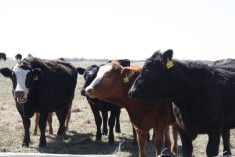This cattle market information is selected from the weekly report from Canfax, a division of the Canadian Cattle Association. More market information, analysis and statistics are available by becoming a Canfax subscriber by calling 403-275-5110 or at www.canfax.ca.
Fed market still hot
Alberta fed steer and heifer prices continue to rally, averaging in the low $250s per hundredweight. That’s only $10 per cwt. below the annual high set in June. Last week was the sixth consecutive week of stronger prices and the first time since August that fed steers traded over $250 per cwt.
Read Also

Volatile temperatures expected for this winter
DTN is forecasting a lot of temperature variability in the Canadian Prairies this winter. Precipitation should be close to average.
Since the beginning of the year, fed steers and heifers have rallied $35.47 per cwt. and $33.58 per cwt., respectively. For the last decade, this is the second strongest rally, only trailing 2014.
Dressed sales were reported at $415-$418 per cwt.
U.S. packer interest was noted, with light volumes of western Canadian fed cattle marketed south. These cattle traded on either side of $255 per cwt. f.o.b. the feedlot. Sales were at a premium compared to local deals.
The Alberta cash-to-futures basis was -$17.93 per cwt., the second weakest since 2004, with only 2022 being weaker.
For the week ending Nov. 30, Canadian fed cattle and cow exports to the United States were 9,206 head, down 36 per cent from last year. This is the largest year-over-year decrease in 2024 and the first time in 12 weeks that exports have fallen below 10,000 head. Year-to-date exports are 532,498 head and remain 15 per cent above last year.
Ontario fed cattle saw two consecutive weeks of stronger prices, averaging in the low $250s per cwt., the highest since August. Dressed sales were reported at $420-$425 per cwt. delivered, trading $4-$5 per cwt. higher than the previous week.
In the U.S., trade in the south was $193 per cwt. In the north live sales were at $193-$195 per cwt., $2-$4 per cwt. higher than the previous week.
Dressed sales were reported at $302-$312 per cwt., $8-$10 per cwt. stronger than the previous week.
Cow prices high
From lows in early November, prices have risen $5.50 per cwt. and are at the highest point since the second half of October.
Last week, D2 cows averaged $172.15 and D3s averaged $158.98 per cwt. Butcher bulls averaged $190.67.
Year-to-date cow slaughter in the West is down 18 per cent from last year and the smallest since 2020, whereas year-to-date cow slaughter in the East is down 24 per cent from last year and the smallest since 2016.
For October, Canadian cow exports to the U.S. were the smallest since 2017. This week is the last full week to buy cows through commercial auction facilities. Western Canadian packers are expected to make a strong push to warehouse some inventory ahead of the holiday season. Premiums are traditionally paid if cows can be delivered to the plant over the holidays.
Record feeder prices
New record highs for feeder cattle are set on a weekly basis. All classes have been impressive, but heavier weight feeders stand out.
This is traditionally the time of the year when 800 pound and heavier feeders establish second half of the year price lows, but that is not the case this year.
Based on AFSC settlement data, over the past two weeks, Alberta 850 lb. feeder prices have been at a $7 per cwt. premium over Saskatchewan and Manitoba. Over the past month, a large volume of feeders were forward priced for the first quarter of 2025 delivery.
Even though cash prices have rallied, the largest price jump has been on forward delivery sales. This week, steers in the three Prairie provinces, weighing 800-899 lb. for February delivery, traded from $360-$386 per cwt.
Based on forward delivery sales, the 850 lb. feeder cash-to-futures basis for February is sitting around plus $6 per cwt. For February, this is the strongest cash-to-futures basis on record.
Reputation bred heifers and young dispersal cows are seeing excellent demand. Volumes have not been large, but a few bred heifers from Alberta and Saskatchewan were sold into Ontario and Quebec.
Last week, bred heifers averaged $4,950 per head, with top end sales at $6,450. Bred cow prices historically decline from December to January. Over the past three years, the average decline is around $85 per head.
If there is a weak spot on the bred market, it is later calving cows and heifers from June and July. Sales for these later calving females are trading at a discount compared to earlier calvers.
Cutouts rise
In U.S. beef trade, cutouts rebounded counter seasonally higher last week. Choice cutouts ended the week up 2.4 per cent to US$315.24 per cwt., their highest point since early November. Select cutouts rallied 1.2 per cent higher to $280.48 per cwt.














